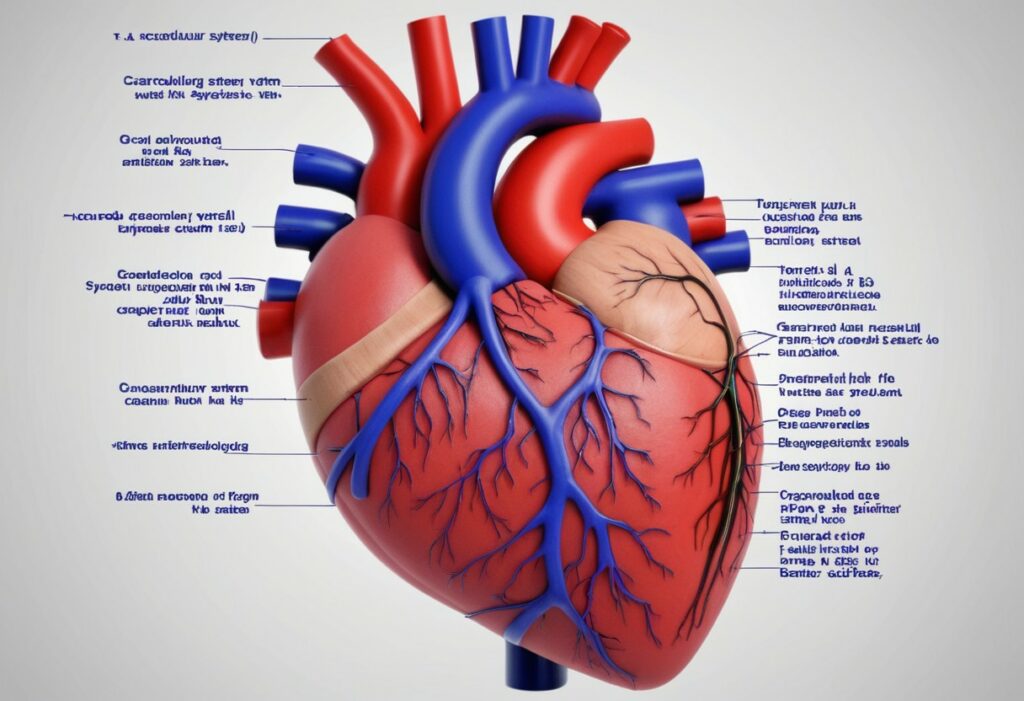The cardiovascular system, also known as the circulatory system, is indispensable to human life. It serves as the body’s transportation network, facilitating the delivery of oxygen, nutrients, hormones, and waste products to and from cells, tissues, and organs. This intricate system is pivotal for maintaining homeostasis, ensuring that the body’s internal environment remains stable despite external changes. From the beat of the heart to the flow of blood through arteries, veins, and capillaries, the cardiovascular system orchestrates a symphony of physiological processes essential for sustaining life.
Understanding the anatomy, function, and significance of the cardiovascular system is paramount for grasping its vital role in overall health and well-being. Comprising the heart, blood vessels, and blood, this complex network works tirelessly to support the body’s metabolic demands and maintain optimal function. The heart, a muscular organ located in the chest cavity, serves as the central pump that propels blood throughout the circulatory system. Meanwhile, blood vessels form an extensive network that transports blood to every corner of the body, ensuring that oxygen and nutrients reach cells while waste products are efficiently removed.
Appreciating the cardiovascular system’s significance underscores the importance of maintaining its health and function. Lifestyle factors such as regular exercise, a balanced diet, and stress management play crucial roles in supporting cardiovascular health and reducing the risk of cardiovascular diseases. By understanding the cardiovascular system’s intricate workings, individuals can make informed decisions to promote their overall well-being and longevity.
Anatomy of the Cardiovascular System:
The cardiovascular system, also known as the circulatory system, is a complex network of organs and vessels responsible for the transportation of vital substances throughout the body. Comprising the heart, blood vessels, and blood, this system ensures the delivery of oxygen, nutrients, hormones, and other essential molecules to cells while removing metabolic waste products. Understanding the anatomy of the cardiovascular system is fundamental to comprehending its intricate structure and function.
The Heart:
At the center of the cardiovascular system lies the heart, a muscular organ roughly the size of a clenched fist located in the chest cavity, slightly left of the body’s midline. The heart consists of four chambers: two atria (singular: atrium) and two ventricles. The right atrium receives deoxygenated blood returning from the body via the superior and inferior vena cavae, while the left atrium receives oxygenated blood from the lungs through the pulmonary veins. The atria contract to pump blood into the ventricles, which in turn pump blood out of the heart.
The right ventricle pumps deoxygenated blood to the lungs via the pulmonary artery, where it becomes oxygenated through gas exchange. Oxygen-rich blood returns to the left atrium via the pulmonary veins, then flows into the left ventricle, which pumps it out to the body through the aorta, the largest artery in the body. This continuous cycle of contraction and relaxation, known as the cardiac cycle, ensures the circulation of blood throughout the body.
Blood Vessels:
Blood vessels form an intricate network that transports blood to and from the heart, delivering oxygen and nutrients to tissues and organs while removing waste products. Arteries carry oxygen-rich blood away from the heart, while veins return oxygen-depleted blood back to the heart. Capillaries, the smallest and most numerous blood vessels, facilitate the exchange of gases, nutrients, and waste products between the blood and surrounding tissues.
Arteries are thick-walled vessels that withstand the high pressure generated by the heart’s pumping action. They branch into smaller arterioles, which further divide into capillaries. Capillaries are thin-walled vessels with a diameter just large enough for red blood cells to pass through in single file. This allows for efficient exchange of gases (oxygen and carbon dioxide), nutrients, and waste products between the blood and surrounding tissues.
Veins carry blood back to the heart, gradually merging into larger vessels as they converge towards the heart. Unlike arteries, veins have thinner walls and contain valves that prevent the backflow of blood. This is especially important in the legs, where blood must travel against gravity to return to the heart. Veins eventually merge into the superior and inferior vena cavae, which deliver deoxygenated blood to the right atrium of the heart.
Blood:
Blood is a specialized fluid composed of cells suspended in a liquid matrix called plasma. It is essential for transporting oxygen, nutrients, hormones, and waste products throughout the body. Blood consists of three main types of cells: red blood cells (erythrocytes), white blood cells (leukocytes), and platelets (thrombocytes).
Red blood cells are responsible for transporting oxygen from the lungs to tissues and organs, as well as removing carbon dioxide from the body. They contain hemoglobin, a protein that binds to oxygen and gives blood its red color. White blood cells play a crucial role in the immune response, defending the body against pathogens and foreign invaders. Platelets are involved in blood clotting, forming a plug to seal off damaged blood vessels and prevent excessive bleeding.
Plasma, the liquid component of blood, is a clear, straw-colored fluid that carries nutrients, hormones, and waste products throughout the body. It also serves as a medium for transporting cells and proteins involved in immune defense and blood clotting. Plasma is composed mainly of water, along with dissolved ions, proteins, lipids, and other molecules essential for maintaining homeostasis.
The anatomy of the cardiovascular system is characterized by its intricate structure and function, with the heart, blood vessels, and blood working together to ensure the continuous circulation of vital substances throughout the body. Understanding the anatomy of this complex system is essential for comprehending its role in maintaining homeostasis and sustaining life. By gaining insight into the structure and function of the cardiovascular system, we can appreciate its significance in overall health and well-being.
Function of the Cardiovascular System:
The cardiovascular system, often referred to as the circulatory system, is a complex network of organs and vessels responsible for the transportation of vital substances throughout the body. Its primary function is to deliver oxygen and nutrients to cells while removing metabolic waste products, thus ensuring the survival and proper function of all tissues and organs. This article explores in detail the function of the cardiovascular system, from the pumping action of the heart to the circulation of blood through arteries, veins, and capillaries.
Pumping Action of the Heart:
At the core of the cardiovascular system lies the heart, a muscular organ responsible for pumping blood throughout the body. The heart consists of four chambers: two atria (singular: atrium) and two ventricles. The right atrium receives deoxygenated blood from the body via the superior and inferior vena cavae, while the left atrium receives oxygenated blood from the lungs via the pulmonary veins. The atria contract to pump blood into the ventricles, which in turn pump blood out of the heart.
The right ventricle pumps deoxygenated blood to the lungs through the pulmonary artery, where it becomes oxygenated through gas exchange. Oxygen-rich blood returns to the left atrium via the pulmonary veins, then flows into the left ventricle, which pumps it out to the body through the aorta, the largest artery in the body. This continuous cycle of contraction and relaxation, known as the cardiac cycle, ensures the circulation of blood throughout the body.
Systemic Circulation:
Once oxygenated blood leaves the left ventricle, it enters the systemic circulation, where it is distributed to all tissues and organs of the body. Arteries carry oxygen-rich blood away from the heart, branching into smaller arterioles and eventually into capillaries. Capillaries are the smallest blood vessels, with thin walls that allow for the exchange of gases, nutrients, and waste products between the blood and surrounding tissues.
Oxygen and nutrients diffuse from the capillaries into the interstitial fluid, nourishing cells and tissues, while waste products such as carbon dioxide and metabolic by-products diffuse from the tissues into the capillaries to be carried away. Deoxygenated blood, now laden with waste products, returns to the heart via venules and veins.
Pulmonary Circulation:
After circulating through the body and delivering oxygen to tissues, deoxygenated blood returns to the heart via the venous system. It enters the right atrium, where it is pumped into the right ventricle and then to the lungs through the pulmonary artery. In the lungs, carbon dioxide is exchanged for oxygen through gas exchange in the alveoli, and the blood becomes oxygenated once again. Oxygen-rich blood returns to the left atrium via the pulmonary veins, completing the pulmonary circulation.
The Role of Blood Vessels:
Blood vessels form an extensive network that facilitates the circulation of blood throughout the body. Arteries carry oxygen-rich blood away from the heart, branching into smaller arterioles that regulate blood flow to tissues and organs. Capillaries, the smallest and most numerous blood vessels, allow for the exchange of gases, nutrients, and waste products between the blood and surrounding tissues.
Veins carry deoxygenated blood back to the heart, gradually merging into larger vessels as they converge towards the heart. Unlike arteries, veins have thinner walls and contain valves that prevent the backflow of blood. This is especially important in the legs, where blood must travel against gravity to return to the heart. Veins eventually merge into the superior and inferior vena cavae, which deliver deoxygenated blood to the right atrium of the heart.
Regulation of Blood Flow:
The cardiovascular system regulates blood flow to meet the changing metabolic demands of tissues and organs. Blood flow is controlled by various mechanisms, including autoregulation, neural regulation, and hormonal regulation. Autoregulation allows tissues to adjust their blood flow in response to changes in metabolic activity, ensuring that oxygen and nutrients are delivered to meet demand.
Neural regulation involves the autonomic nervous system, which controls heart rate and blood vessel diameter. Sympathetic stimulation increases heart rate and constricts blood vessels, while parasympathetic stimulation decreases heart rate and dilates blood vessels. Hormonal regulation involves hormones such as adrenaline and noradrenaline, which are released in response to stress or exercise and increase heart rate and blood pressure.
The cardiovascular system plays a vital role in maintaining homeostasis and sustaining life by delivering oxygen and nutrients to cells while removing metabolic waste products. From the pumping action of the heart to the circulation of blood through arteries, veins, and capillaries, every component of the cardiovascular system works together to ensure the efficient transport of vital substances throughout the body. Understanding the function of the cardiovascular system is essential for comprehending its significance in overall health and well-being.
Importance of the Cardiovascular System:
The cardiovascular system, often hailed as the lifeline of the human body, is indispensable for maintaining overall health and vitality. Consisting of the heart, blood vessels, and blood, this complex network serves a multitude of vital functions that are essential for sustaining life and promoting well-being. From regulating blood pressure and electrolyte balance to supporting immune function and tissue repair, the cardiovascular system plays a central role in maintaining homeostasis and ensuring the proper function of organs and tissues throughout the body. This article delves into the importance of the cardiovascular system, highlighting its critical functions and the implications of dysfunction or disease.
Regulation of Blood Pressure:
One of the primary functions of the cardiovascular system is to regulate blood pressure, the force exerted by circulating blood against the walls of blood vessels. Blood pressure is essential for ensuring adequate perfusion of tissues and organs with oxygen and nutrients. The heart, through its pumping action, generates the pressure needed to propel blood through the arteries and into the capillaries. Arterial blood pressure is carefully controlled by a complex interplay of neural, hormonal, and local mechanisms to maintain adequate tissue perfusion while preventing excessive strain on the heart and blood vessels.
Electrolyte Balance:
The cardiovascular system plays a crucial role in maintaining electrolyte balance, which is essential for proper cellular function and overall health. Electrolytes, such as sodium, potassium, calcium, and magnesium, are charged ions that play key roles in nerve conduction, muscle contraction, and fluid balance. The kidneys, in coordination with the cardiovascular system, regulate electrolyte levels in the blood by adjusting the excretion and reabsorption of ions. Imbalances in electrolyte levels can lead to disturbances in cardiac rhythm, muscle weakness, and other serious health problems.
Temperature Regulation:
The cardiovascular system contributes to the regulation of body temperature by redistributing heat throughout the body. During exercise or exposure to high temperatures, blood flow to the skin increases, allowing excess heat to be dissipated through the skin’s surface. Conversely, in cold environments, blood flow to the skin decreases to conserve heat and maintain core body temperature. This thermoregulatory mechanism helps to prevent overheating or hypothermia and ensures the body remains within a narrow temperature range conducive to optimal physiological function.
Support of Immune Function:
The cardiovascular system plays a critical role in supporting immune function by transporting immune cells, antibodies, and other components of the immune system to sites of infection or injury. White blood cells, such as lymphocytes and neutrophils, are carried through the bloodstream to areas of inflammation or infection, where they help to combat pathogens and initiate the immune response. In addition, antibodies produced by the immune system are transported through the bloodstream to neutralize pathogens and promote the clearance of infection.
Promotion of Tissue Repair:
The cardiovascular system contributes to tissue repair and wound healing by delivering oxygen, nutrients, and growth factors to injured tissues. Blood vessels facilitate the migration of immune cells and fibroblasts to the site of injury, where they help to remove debris, promote tissue regeneration, and form new blood vessels. Adequate blood flow is essential for ensuring timely and effective tissue repair, and disruptions in blood supply can impair the healing process and lead to chronic wounds or tissue damage.
Implications of Cardiovascular Dysfunction:
Dysfunction or diseases of the cardiovascular system can have serious consequences and significantly impact quality of life. Conditions such as hypertension (high blood pressure), coronary artery disease, heart failure, arrhythmias, and peripheral artery disease are among the most common cardiovascular disorders. These conditions can increase the risk of heart attack, stroke, kidney disease, and other serious complications if left untreated. Prevention, early detection, and management of cardiovascular diseases are crucial for reducing morbidity and mortality and improving overall health outcomes.
The cardiovascular system is a complex and essential network that ensures the delivery of oxygen and nutrients to cells throughout the body. Its critical functions, including the regulation of blood pressure, electrolyte balance, body temperature, immune function, and tissue repair, are vital for sustaining life and promoting overall health and well-being. Dysfunction or diseases of the cardiovascular system can have serious consequences and significantly impact quality of life. By promoting cardiovascular health through lifestyle modifications, regular exercise, proper nutrition, and timely medical intervention, individuals can support the function of this critical system and reduce the risk of cardiovascular diseases.
Disclaimer:
The information provided in this article is for informational purposes only and is not intended as medical advice. It is not a substitute for professional medical diagnosis, treatment, or advice. Always seek the advice of your physician or other qualified healthcare provider with any questions you may have regarding a medical condition or treatment plan.










More Stories
Inside the Hormonal Symphony: Understanding the Endocrine System
Understanding Gallstones: Causes, Symptoms, and Treatment Options
The Intricacies of Cells: Exploring the Building Blocks of Life